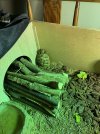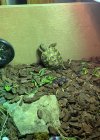Pippa+Tortellini
New Member
Hey ? I’m a first time tortoise owner of 2 weeks and I’m trying to get to know my new 2year old hermann, Tortellini.
He weighs 44g and is about 6cm
So far I think things have been going well.. he tends to sleep quite a lot, which I’m not sure is normal but when he’s awake he tends to be quite active.
I bathe him frequently but I can’t seem to get him to say in the tub long? The water is warm and not to deep/shallow. He always tries to climb out.
I’ve been feeding him leafy greens like rocket, curly kale, the occasional bit of courgette and mix salad. I plan to feed him more weeds and naturally grown veg when the weather gets better.
One thing that is concerning me is quite a lot though is that recently he has been trying to climb the sides of his tortoise table?! He will go to every corner and every wall and stand on his back legs and try to climb.
The dimensions of his house are 32inchX16inch
I use a combination of coco coir, orchard bark and tortoise substrate to give him some variety around his home. I also have a small humid hide with sphagnum moss and part of his enclosure is closed with some dustless hay. He has a flexiwood tunnel, basking rock and water bowl.
The temps are usually around 30°c in the day and 24° at night with humidity between 40-50%
I hope I’m doing the right things and I am more than open to receiving advice and constructive criticism!!! I just want to do right by my lil tort!
I’ve attached some pics of Tortellini trying to climb up the walls
Thank you! X
He weighs 44g and is about 6cm
So far I think things have been going well.. he tends to sleep quite a lot, which I’m not sure is normal but when he’s awake he tends to be quite active.
I bathe him frequently but I can’t seem to get him to say in the tub long? The water is warm and not to deep/shallow. He always tries to climb out.
I’ve been feeding him leafy greens like rocket, curly kale, the occasional bit of courgette and mix salad. I plan to feed him more weeds and naturally grown veg when the weather gets better.
One thing that is concerning me is quite a lot though is that recently he has been trying to climb the sides of his tortoise table?! He will go to every corner and every wall and stand on his back legs and try to climb.
The dimensions of his house are 32inchX16inch
I use a combination of coco coir, orchard bark and tortoise substrate to give him some variety around his home. I also have a small humid hide with sphagnum moss and part of his enclosure is closed with some dustless hay. He has a flexiwood tunnel, basking rock and water bowl.
The temps are usually around 30°c in the day and 24° at night with humidity between 40-50%
I hope I’m doing the right things and I am more than open to receiving advice and constructive criticism!!! I just want to do right by my lil tort!
I’ve attached some pics of Tortellini trying to climb up the walls
Thank you! X


